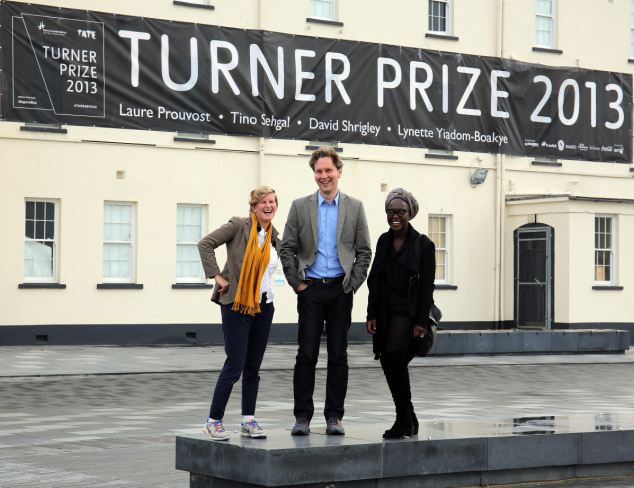And this time around, we give you a peek into what the Turner Prize awardees put up on those pedestals this year. Presenting a review of Turner Prize 2013 for visual arts- By Aileen Blaney.
‘But is it art?’ – the Turner prize shortlist’s most asked question has long since become a staple of audience reactions to the enfant terrible of Britain’s art establishment. ‘How will you REACT?’, marketing hook for the 2013 prize, playfully nods to its naysayers, showing that Turner is not above a joust with the critics and public. Significantly, 2013 marks the first time the 29 year-old prize has left the privilege of its parental home in the Tate London for an altogether more edgy location in Derry, Northern Ireland – situated both at the edge of the United Kingdom and, until the paramilitary ceasefires of the 90s, at the centre of political violence between British forces and Irish militant republicanism. Location counts and this year’s reactions are split between a contested city and the shortlisted artists.
The youthful Peace Bridge, slung rope-like across the river Foyle, uniting the Protestant Waterside with Cityside, home to Derry’s Catholics, is a momentous gateway to the exhibition site of the 2013 Turner prize exhibition. To its credit, the Turner Prize is not squeamish of the city’s still fresh sectarian scars. Rather than opting for the safety of one of its contemporary art spaces, the exhibition is being staged in two red brick Victorian terraced houses, the former dormitory in a 19th Century British military barracks where soldiers were stationed throughout the ‘troubles’ (1969 – 1994), and gifted to the people of Northern Ireland as a gesture supporting its Peace Process in 2003.
Uprooting the Turner from its native sod in London is part of a strategy to widen and diversify its audience base. First impressions formed in a foyer teeming with people across different age brackets and socio-economic backgrounds indicate that it has pulled this off. The usual art crowd used to wearing its privilege on the finest of tailored sleeves have lost their majority. In their place is a mixed audience that puts human form to the art policy and marketing department’s well-worn line that ‘art is for everyone’. This is born out in gallery one where David Shrigley applies his creativity to winning the public’s participation. How ironic that for an artist’s whose drawings have been in so many places – galleries, broadsheet newspapers, books, magazines and websites – that here they are nowhere to be seen. Instead, Shrigley has passed his easel to the masses and given the gallery’s canvas white walls to them too.
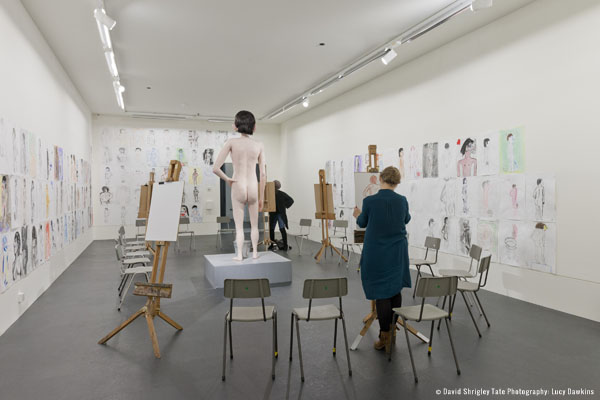
Life Model 2012 (installation)
That Shrigley likes having a good laugh with his audiences is well known. And yet his artworks could never stand accused of lacking gravitas. Visual puns, send-ups and art-historical witticisms, drawn in his characteristic cack-handed style, reveals the artist’s philosophy as one that takes the tragic-comedy of life, more so than art, seriously. The show must go on however, with or without these funny asides, and so it does for standing centre stage posing as though for a life drawing class is a giant animatronic doll with a big bushy head of hair, ungainly proportions – facial and bodily – and a weak bladder, necessitating it to pee into a tin bucket every 5 or so minutes.
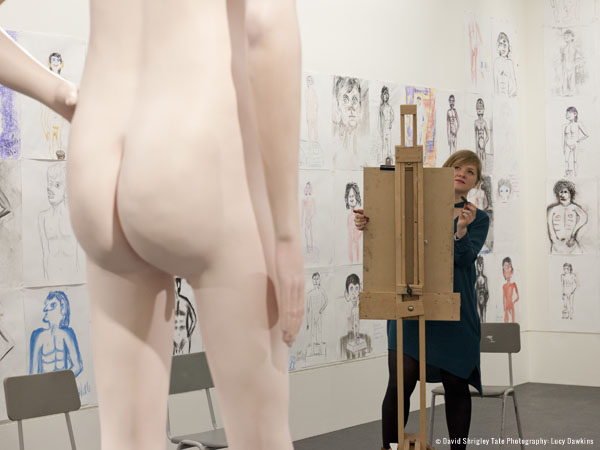
Life Model 2012 (installation)
In seats scattered around Shrigley’s life drawing model people sit at easels earnestly sketching; an invigilator, meanwhile, is run off her feet supplying fresh paper and receiving finished pieces. Wallpapering the room are the public’s drawings, the products of hands both unaccustomed to setting a crayon free across paper and those either with the advantage of formal training or naturally predisposed to rendering the model’s likeness with fluid lines and curves. This is an exhibition with a ‘those that do can’ attitude, rotating daily to ensure that everyone who gets involved becomes part of the exhibition. Shrigley’s Turner nomination was on the back of Brain Activity at London’s Hayward Gallery, a show cram packed with his cartoons, paintings, animated film and sculpture. Looking down at my own lumpish drawing, I couldn’t help wanting to see something hand made by Shrigley in its place and feeling that despite all the participatory good cheer, his show is the worst for it.
A half hour queue precedes entry into Laure Prouvost’s immersive installation. There are two ways of viewing Prouvost: embrace its zaniness or do battle with its perplexity. Prouvost is a storyteller, but not in the traditional sense. Her stories as she points out don’t deal with the bigger life questions but rather with how and what we see in our immediate environments. The film Wantee, in memory of her grandfather who in his last grand flourish as a conceptual artist disappeared into a tunnel he was building between his home in France and faraway Africa, plays in a room filled with the detritus of her famous grandfather’s sitting room simultaneously being represented on screen. Walking in to the space is like entering a cinema late when everyone is seated and the lights are down. Except here, when eyes have adjusted to the dark, it is chintz that comes into view: there are the shelves holding ornaments in porcelain, pictures mounted to walls, and an overabundance of misshapen teapots that appear to be growing out of tables prettified with antique linen.
All this seems a touching memorial to a loved one who counted modernist artists such as Kurt Schwitters, credited with fathering the now ubiquitous installation art, among his friends, until the penny drops that we are immersed in a fictitious set-up. A low, child height door opens into another room where a sloping pink carpeted floor and low ceiling lends to its occupants the sensation of being in a Wendy house. On its wall, another film plays. This one, showing the artist’s fictional grandmother, zips along with the aid of Prouvost’s characteristic fast cuts and mischievous humour.
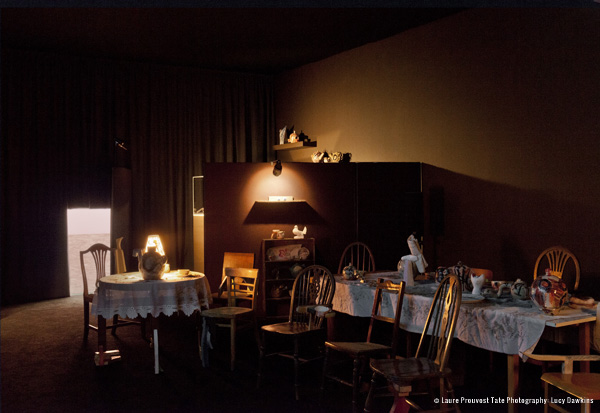
Installation View
Although Prouvost would say that ‘the viewer is boss’ and that nothing in her stories and images stops them from making their own meanings, the artworks occcupy a wavelength whose signal is both near and far; at times, their directness makes getting it an easy effort; at others, there’s a solipsism that is hard to penetrate. But that didn’t stop Prouvost from ultimately wining the grand prize, and her admirers are many, distributed across the critical fraternity and gallery goers, who in this instance were sitting eyes glued to her film’s off the wall stories and beguiled by her lilting childish voice over.
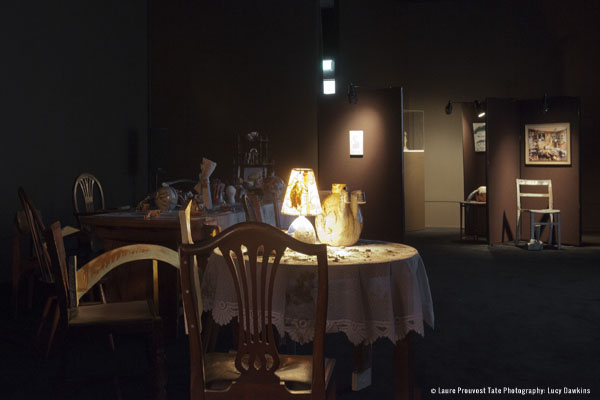
Installation View
Hot favourite for this year’s prize before it was awarded to Prouvost was Tino Sehgal, who was born in London to a Pakistani father and raised in Germany. In an immaterial art practice, live encounters between people are the artwork. Although Sehgal’s art is in the service of debates about contemporary issues, it is his deft choreography of space and intimacy between strangers that has brought him into the running. Sadly, the anticlimax produced by his Turner exhibition is proportionate with its hype. In what has the appearance of a disused gallery, visitors are approached by what is at first glance another invigilator dressed in the Turner merchandise t-shirt who promptly offers them the deal of the day: your views on the market economy in exchange for £2.
Performance art of this nature is as good as the interaction, which in turn is as good as the artist’s emmissary, and also, but less so, the individual being engaged. In this case, the agent provocateur was not at all interested in my views, had no views of her own – having tried to ply me with the day’s selection ‘of what other people are saying’ – and could not get to the end of the conversation fast enough, so impatient was she to reach the grand giveaway moment. I had views on the economy, but in this market there was no room for them.
Ghanaian born Lynette Yiado-Boakye portraits capture their subjects in fleeting moments of undress, leisure and gunfire. In ‘The Generosity’, a gloaming light clothes two men in their underwear, bending double as they pull on their socks. Onlookers are left in a state of not knowing and yet knowing enough of what has some moments before passed between them. In another portrait, a gentleman in white briefs and, more fittingly, an army green jacket, is planted stock still in high grass, poised to fire a rifle held at shoulder level. In both cases, the drama of what has unfolded and is about to happen is elusive yet gripping. Traditionally rendered, Yiado-Boakye’s paintings give the appearance of portraits of real people but are infact inventions owing their lineage not to history but to the artist’s scrapbook of found images and own imaginings. ‘I suppose its the difference between working between a person you want to capture and one you want to invent’, she shares in the accompanying exhibition film. Yiado-Boakye is working from a compulsion to tell stories as much as paint: ‘I write what I can’t paint and I paint what I can’t write’.
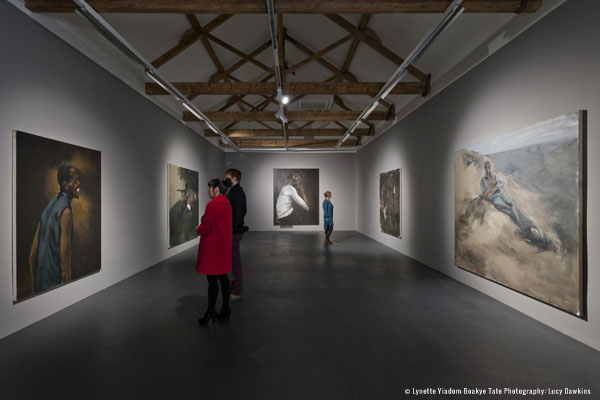
Installation View
The inclusion of a painter in a competition that has celebrated a pickled shark, the lights of a gallery going on and off and Tracey Emin’s unmade bed might suggest that the prize is getting conservative in its old age. From the point of view of the contemporary art world, painting has been the preserve of art history and not where art ‘is at now’. Rather ironically then, by being thus far excluded it has again acquired the ephemeral quality of newness. Concurrent with painting being a newish medium for the Turner, the black subjects of Yiado-Boakye’s portraits are seen as something new in the trajectory of Western figurative art. Although Yiado-Boakye’s intervention is certainly better late than never, is it not extraordinary that it has taken a contemporary art prize in 2013 to bring the black subject into the frame?













